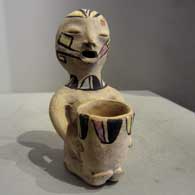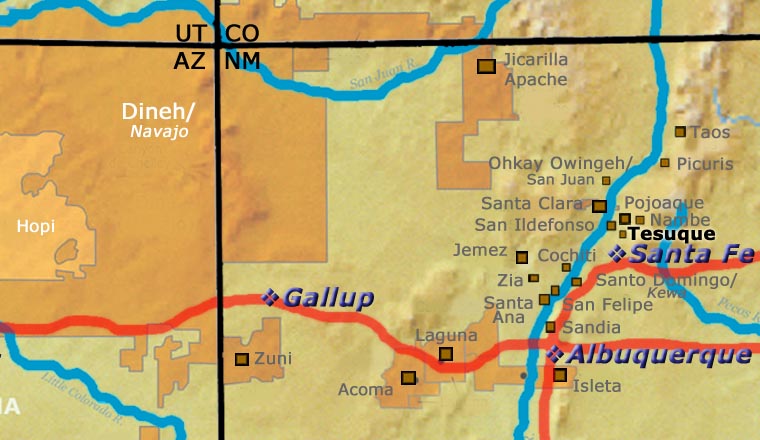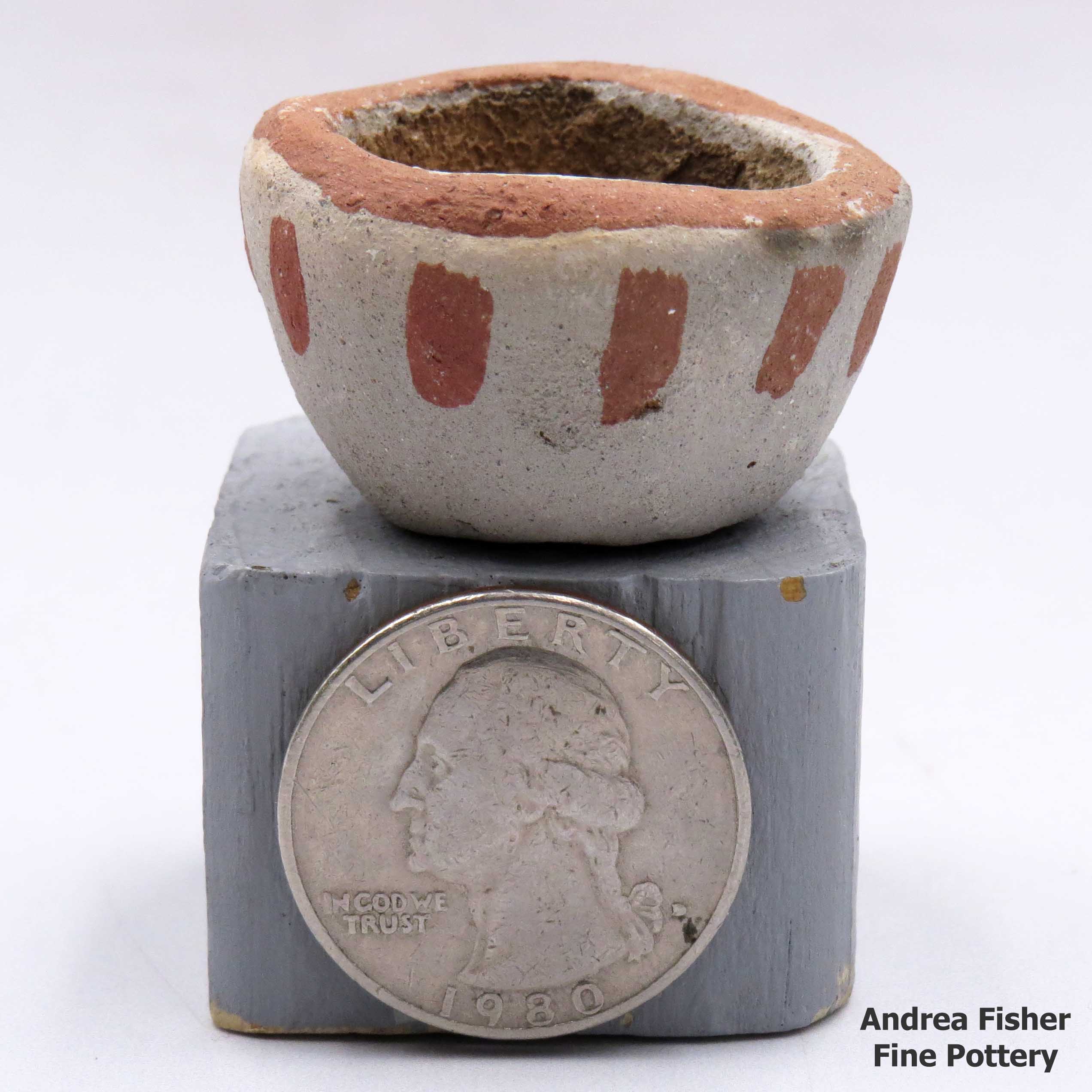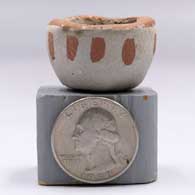
Tesuque Pueblo

A Tesuque Rain God
Tesuque Pueblo is located about 10 miles north of today's city of Santa Fe, New Mexico. Archaeologists have dated a few sites in the Tesuque Valley back to about 850 AD. By 1200 AD there were many small villages in the area but when the Spanish arrived in 1540, they found only six villages left. The main Tesuque Pueblo (at that time) was located about 3 miles east of today's pueblo.
During the Pueblo Revolt of 1680 it was a pair of Tesuque runners who misled the Spanish as to when the tribes planned to revolt. The Spanish governor killed the runners for their efforts, then saw many of his Spanish subjects killed when it turned out the "date" was wrong and the tribes revolted early. At Tesuque the warriors killed the local priest and another government official immediately, then marched to the Palace of the Governors in Santa Fe to join with the warriors of other pueblos in that confrontation with the Spanish. A few days later, the Spanish were allowed to leave the Palace of the Governors peacefully and begin the long march south on the Camino Real back to Mexico.
When Don Diego de Vargas returned at the head of Spanish troops (the Conquistadors) in 1692 and began to reconquer northern Nuevo Mexico, one of the first things they did was burn and tear down the main Tesuque village. Shortly after that the tribe officially submitted to Spanish rule, moved to the present pueblo site and began rebuilding in 1694.
Between changes of government, European-introduced diseases, European encroachment on pueblo land and general disregard for the people of the pueblos, the next 200 years were not kind to the Tesuque people and by 1910 the pueblo's population was down to 77.
Today there are about 800 members of the Tesuque tribe living on a reservation of more than 17,000 acres. The tribe operates the Tesuque Casino and Hotel, and the Camel Rock Suites (on South St. Francis Drive in Santa Fe).
Before the 1800s, Tesuque pottery mostly resembled the pottery produced at San Ildefonso at that time. Around 1830 that began to change as Tesuque potters experimented with newly found clays and slips that shortly made Tesuque Polychrome a style of its own. That style was quite popular until an Anglo trader named Jake Gold appeared. Gold convinced most of the Tesuque potters to make small figurines he called "Rain Gods." He also convinced them to paint those figurines with commercial paint. Gold did an outstanding marketing job and soon Tesuque potters were turning out Rain Gods by the thousands. They were distributed nation wide and many manufacturers bought them by the barrel to use as promotional items. That mass production ended up virtually destroying pottery making at Tesuque. In the 1920s the demand for Rain Gods diminished and the potters turned to making other low quality goods painted with commercial "Day-Glo" poster paint.
In the 1930s and 1940s only a handful of Tesuque potters were producing but Catherine Vigil persevered through those times making traditional Tesuque polychrome pottery. In the 1960s a few young potters took up where Catherine left off and a small revival of traditional pottery making began at Tesuque. However, the tribe's commercial ventures these days have pretty much replaced any pottery making.
100 West San Francisco Street, Santa Fe, New Mexico 87501
(505) 986-1234 - www.andreafisherpottery.com - All Rights Reserved

100 West San Francisco Street, Santa Fe, New Mexico 87501
(505) 986-1234 - www.andreafisherpottery.com - All Rights Reserved

Miniatures
Most people think that miniature pottery is something new in the world of Native American pottery. In reality, archaeologists have found miniature pottery in the remains of ancient ruins in Chaco Canyon, Mesa Verde, across eastern Arizona, southern New Mexico and south to the Paquimé and Casas Grandes region in northern Mexico. Archaeologists working in the eastern US have found miniature pottery spread across Early Woodland Culture sites, too, dated up to 1700 years ago.
We have no idea as to why the ancients created miniature pottery but there's lots of speculation. Perhaps it was made as toys for children. Perhaps it was made by children learning to make pottery, and as their expertise grew, the size of their pieces grew, too. Perhaps it was made and placed in a firing pit as a good luck charm, hoping that other pots being fired in the pit would survive the firing process and not crack or break. Perhaps it was made for some ceremonial purpose we have no possibility of knowing. We do know that in North America, almost every pottery-making group of ancients made miniature pottery. They decorated it, too, just like the full size pottery the women of the time were making.
As the rebirth of traditionally made Native American pottery has unfolded over the last century, research into the ancient forms, styles and designs has also brought the miniature back into focus. There are more than a few potters these days making tiny gems again, similar to and, at the same time, more refined than the products of the potters of prehistory. And while some are still being made by children learning as they grow up, many more are being made by established adult potters. Some have made their entire careers around the making of miniatures while others sometimes make a few miniatures to complement the full range of forms and styles of full size pieces they make.
100 West San Francisco Street, Santa Fe, New Mexico 87501
(505) 986-1234 - www.andreafisherpottery.com - All Rights Reserved


